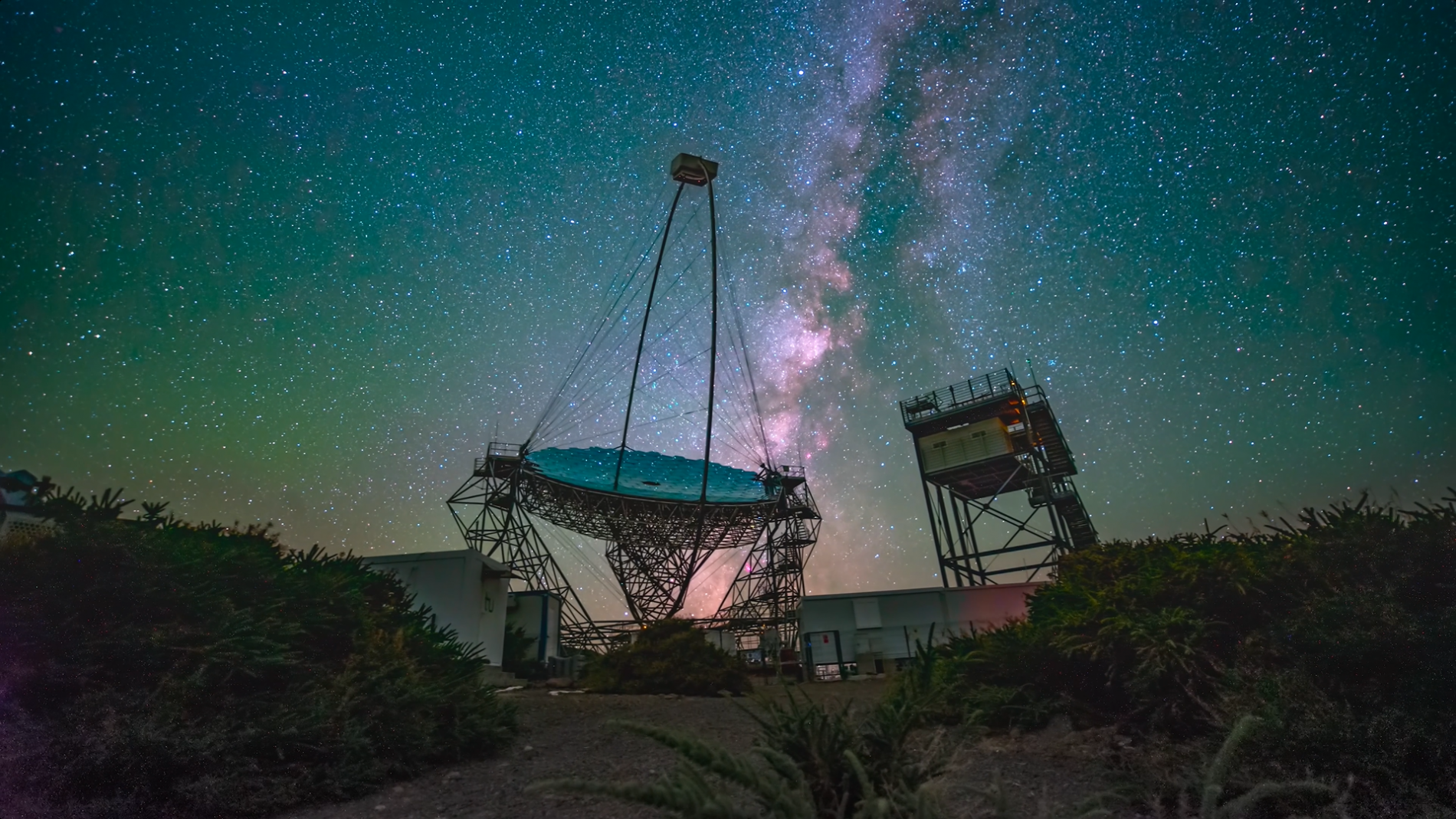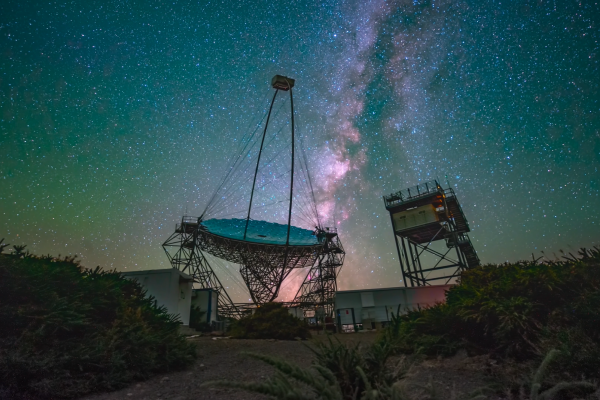On 15 December, the Large-Sized Telescope (LST) Collaboration announced via an Astronomer's Telegram (ATel) the detection of the source OP 313 at very high energies with LST-1. Although OP 313 was known at lower energies, it had never been detected above 100 GeV, making this the first scientific discovery of LST-1. With these results, OP 313 becomes the most distant Active Galactic Nucleus (AGN) ever detected by a Cherenkov telescope, demonstrating once again the outstanding performance of the LST prototype as it continues its commissioning at CTAO-North on the island of La Palma.
OP 313 is a type of AGN known as a Flat Spectrum Radio Quasar or FSRQ. These are very luminous objects found at the centres of some galaxies, where a supermassive black hole devours material from its surroundings, creating powerful accretion discs and jets of light and relativistic particles.
The LST-1 observed this source between 10 and 14 December, after receiving an alert from the Fermi-LAT satellite showing unusually high activity in the low-energy gamma-ray range, which was also confirmed in the optical range with different instruments. With only four days of data, the LST Collaboration was able to detect the source above 100 Gigaelectronvolts (GeV), an energy level a billion times higher than the visible light that humans can perceive.

LST-1 Telescope, in La Palma. Credit: CTAO gGmbH
Only nine quasars are known at very high energies, and OP 313 is now the tenth. In general, quasars are more difficult to detect at very high energies than other types of AGN. This is not only because the brightness of their accretion disk weakens the emission of gamma rays, but because they are further away. In this case, OP 313 is located at a redshift of 0.997 or ~8 billion light years away, making it the most distant AGN and the second most distant source ever detected at very high energies.The more distant the source, the more difficult it is to observe at very high energies due to the so-called Extragalactic Background Light or EBL. The EBL is the collective light emitted by all objects outside the Milky Way that expands across multiple wavelengths, from visible, infrared and ultraviolet. The EBL interacts with very high-energy gamma rays, attenuating their flux and, thus, making their observation challenging. The characteristics of the LST-1, with an optimized sensitivity for the CTAO’s low energy range, between 20 and 150 GeV, where gamma rays are less affected by the EBL, enabled the LST Collaboration to extend the study of this source to tens of GeV for the first time.
The LST Collaboration will continue to observe this source with the LST-1 to expand the dataset and, thus, obtain a more precise analysis that allows scientists to improve their understanding of the EBL, study the magnetic fields within this type of source or delve into fundamental intergalactic physics.
About the LST
The Large-Sized Telescope (LST) is one of three types of telescopes that will be built to cover the entire energy range of the CTAO (20 GeV - 300 TeV). Four LSTs will be installed at the centre of the northern hemisphere array on La Palma, Spain, and two more are planned for the southern hemisphere array. These telescopes are optimised to cover the low-energy sensitivity between 20 and 150 GeV. Each LST is a giant 23-metre diameter telescope with a mirror area of about 400 square metres and a pixel camera consisting of 1855 light sensors capable of detecting single photons with high efficiency. Although the LST is 45 metres tall and weighs about 100 tonnes, it is extremely agile and has the ability to reposition itself in 20 seconds to capture brief, low-energy gamma-ray signals. Both the fast repositioning speed and the low energy threshold provided by LSTs are essential for studies of transient gamma-ray sources in our own galaxy and for the study of active galactic nuclei and gamma-ray bursts at high redshift. The LST prototype, LST-1, is built at CTAO-North and is currently in commissioning. It is expected to become CTAO's first telescope once commissioning is completed and it has been officially accepted.
The LST Collaboration consists of more than 400 scientists and engineers from 67 different institutions in twelve countries. Telescope operations and maintenance, as well as data collection, analysis, and technical and scientific publications, are only possible thanks to the collaborative effort of the entire LST Collaboration.
About the CTAO
The Cherenkov Telescope Array Observatory (CTAO) will be the first ground-based gamma-ray observatory open to the scientific community and the world's largest and most sensitive instrument for exploring the Universe at high energies. The CTAO's unparalleled precision and wide energy range (20 GeV-300 TeV) will provide novel insights into the most extreme and powerful events in the Cosmos, addressing questions inside and outside astrophysics that fall under three main themes: understanding the origin and role of relativistic cosmic particles, studying extreme environments (such as black holes and neutron stars) and exploring frontiers in physics (such as the nature of dark matter). To do this, the CTAO will use three types of telescopes: Large-Sized Telescopes (LSTs), Medium-Sized Telescopes (MSTs) and Small-Sized Telescopes (SSTs). More than 60 telescopes will be distributed between two telescope arrays: CTAO-North in the northern hemisphere at the Roque de los Muchachos Observatory of the Instituto de Astrofísica de Canarias (IAC) on La Palma (Spain), and CTAO-South in the southern hemisphere near the Paranal Observatory of the European Southern Observatory (ESO) in the Atacama Desert (Chile). The CTAO headquarters are hosted at the Istituto Nazionale di Astrofisica (INAF) in Bologna (Italy), and the Science Data Management Centre (SDMC) is hosted at the Deutsches Elektronen-Synchrotron (DESY) in Zeuthen (Germany). The CTAO will also be the first observatory of its kind to be open to the scientific communities worldwide as a resource for data from unique, high-energy astronomical observations.
The CTAO gGmbH works closely with partners around the world for the development of the Observatory. Key partners include in-kind contribution teams, such as the telescope teams that are developing essential hardware and software, as well as CTAC, an international group of researchers who have provided scientific guidance since the beginning of the project.
The CTAO was promoted to "Milestone" in the 2018 Roadmap of the European Forum on Research Infrastructures (ESFRI), and was ranked as the top priority among new ground-based infrastructures in the ASTRONET Roadmap 2022-2035.



